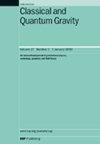辐射型施瓦兹柴尔德黑洞外基于距离的量子资源分布
IF 3.6
3区 物理与天体物理
Q2 ASTRONOMY & ASTROPHYSICS
引用次数: 0
摘要
本研究旨在探究费米子场在弯曲的施瓦兹柴尔德时空(SST)中基于距离的量子资源分布,以及玻色子场在平坦的闵科夫斯基时空和弯曲的施瓦兹柴尔德时空中基于距离的量子资源分布。为此,我们将研究坠入施瓦兹柴尔德黑洞(SBH)的观察者与其静止伙伴之间的量子资源。此外,我们还将探索两个匀加速探测器与闵科夫斯基真空中的玻色场相互作用时产生的量子资源。此外,我们还将研究这些探测器与 SBH 外部哈特尔-霍金真空和布尔沃真空中的玻色场之间的相互作用。在无限霍金温度下,费米子场的量子资源会退化;退化速度取决于观察者与事件穹界之间的距离、费米子频率模式和吉辛状态参数。对于玻色子场,我们的研究结果表明,纠缠力是单调递减的,要么趋于零,要么趋于恒定值。此外,随着 Unruh 温度的升高,相干性和不和性会突然死亡,然后突然诞生,对于给定的初始状态,纠缠无法恢复。根据我们的发现,费米-狄拉克统计量和玻色-爱因斯坦统计量似乎代表了费米子和玻色子情况下量子资源分布的主要差异。这些发现对于加深我们对相对论框架中量子资源分布的理解可能至关重要。本文章由计算机程序翻译,如有差异,请以英文原文为准。
Distribution of distance-based quantum resources outside a radiating Schwarzschild black hole
This study aims to investigate the distribution of distance-based quantum resources for fermionic fields in curved Schwarzschild spacetime (SST), as well as for bosonic fields in both flat Minkowski and curved SSTs. To achieve this, we will examine the quantum resources between an observer falling into a Schwarzschild black hole (SBH) and their stationary partner, who shares a Gisin state. Additionally, we will explore the quantum resources that arise when two uniformly accelerated detectors interact with bosonic fields in the Minkowski vacuum. Furthermore, we will investigate the interactions between these detectors and bosonic fields in the Hartle–Hawking and Boulware vacuums outside the SBH. At an infinite Hawking temperature, the quantum resources for the fermionic fields degrade; the rate of degradation is dependent on the distance between the observer and the event horizon, the fermionic frequency mode, and the Gisin state parameters. In the case of the bosonic fields, our results show that entanglement decreases monotonically, either towards zero or a constant value. Moreover, with increasing Unruh temperature, coherence and discord undergo sudden death followed by a sudden birth, and entanglement cannot be revived for a given initial state. Based on our findings, it appears that the Fermi–Dirac and Bose–Einstein statistics represent the primary differences in quantum resource distribution between the fermionic and bosonic cases. These findings may be essential for enhancing our understanding of the distribution of quantum resources in relativistic frameworks.
求助全文
通过发布文献求助,成功后即可免费获取论文全文。
去求助
来源期刊

Classical and Quantum Gravity
物理-天文与天体物理
CiteScore
7.00
自引率
8.60%
发文量
301
审稿时长
2-4 weeks
期刊介绍:
Classical and Quantum Gravity is an established journal for physicists, mathematicians and cosmologists in the fields of gravitation and the theory of spacetime. The journal is now the acknowledged world leader in classical relativity and all areas of quantum gravity.
 求助内容:
求助内容: 应助结果提醒方式:
应助结果提醒方式:


